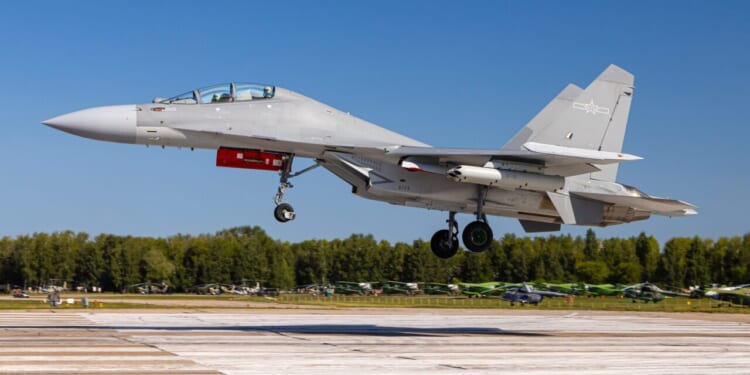The Shenyang J-16 represents China’s 4.5-generation multirole strike fighter platform.
Chinese state-run media outlets recently claimed that it successfully forced two American-made F-22 Raptor fighter jets out of the nation’s Air Defense Identification Zone (ADIZ). As part of this so-called “close encounter,” a J-16 fighter pilot detected and locked on to a pair of Raptor jets before escorting them away. While Beijing has not confirmed the American jets were absolutely of the F-22 variety, former People’s Liberation Army colonel Yue Gang assessed that the aircraft were either Raptors or F-35 Lightning II jets. This report has yet to be verified; however, Beijing would clearly like it known that its military’s ability to detect, track, and even engage some of the most advanced stealth aircraft in service across the planet is only improving.
The J-16
The Shenyang J-16, designated by NATO as the “Flanker-N,” represents China’s 4.5-generation multirole strike fighter platform. While the series was first manufactured in 2017, it was derived from Soviet-era technology. Following the collapse of the Cold War, China procured USSR-designed Sukhoi SU-27 and Su-30MKK fighters from the newly installed Russian government. As part of this deal, Beijing acquired those jets along with a license to produce them in China as the J-11A. The succeeding J-16 was born from this Soviet platform. Notably, the J-16 functions as a bridge between China’s aging airframes and its newer J-20 and J-31 stealth fighters. “These two new-generation jets would be too expensive to mass produce in the necessary numbers required to fully modernise the PLA Air Force’s combat fleet,” Collin Koh, a researcher at Nanyang Technological University in Singapore, told the South China Morning Post. “Hence, the J-16 is crucial to bridge this gap.” The J-16 features active electronically scanned array AESA radar and other enhancements that give it an edge over its Soviet-era counterparts. While the platform is not considered stealthy, some J-16 units have reportedly received radar-absorbent paint to help lower their detectability in the air.
The F-22
As the world’s first ever fifth-generation platform to fly the skies, the F-22 arguably remains the most recognizable aircraft. The supersonic stealth fighter was initially intended as an air superiority fighter, but it is also capable of serving in ground attack, signals intelligence, and electronic warfare roles. Today, the remaining Raptor jets remain a critical component of the US Air Force’s aerial strategy and are likely to remain relevant until the introduction of the upcoming F-47 platform in the next decade. The Raptor’s tiny radar cross-section enables the aircraft to fly at supersonic speeds without risking detection. Notably, the Raptor is considered to be stealthier than the newer F-35 Lightning II. In terms of power, a pair of Pratt & Whitney F110-PW-110 turbofan engines provides a total thrust of around 70,000 pounds, enabling the jet to outmatch any counterpart in a dogfight. The Raptor can pack a lethal armament load, also contributing to its dogfighting prowess. The F-22 can carry a range of air-to-air and air-to-ground weapons, including precision-guided bombs like the Joint Direct Attack Munitions (JDAM) and AIM-120 and AIM-9 Sidewinders.
About the Author: Maya Carlin
Maya Carlin, National Security Writer with The National Interest, is an analyst with the Center for Security Policy and a former Anna Sobol Levy Fellow at IDC Herzliya in Israel. She has by-lines in many publications, including The National Interest, Jerusalem Post, and Times of Israel. You can follow her on Twitter: @MayaCarlin. Carlin has over 1,000 articles published over the last several years on various defense issues.
Image: Fasttailwind / Shutterstock.com

















